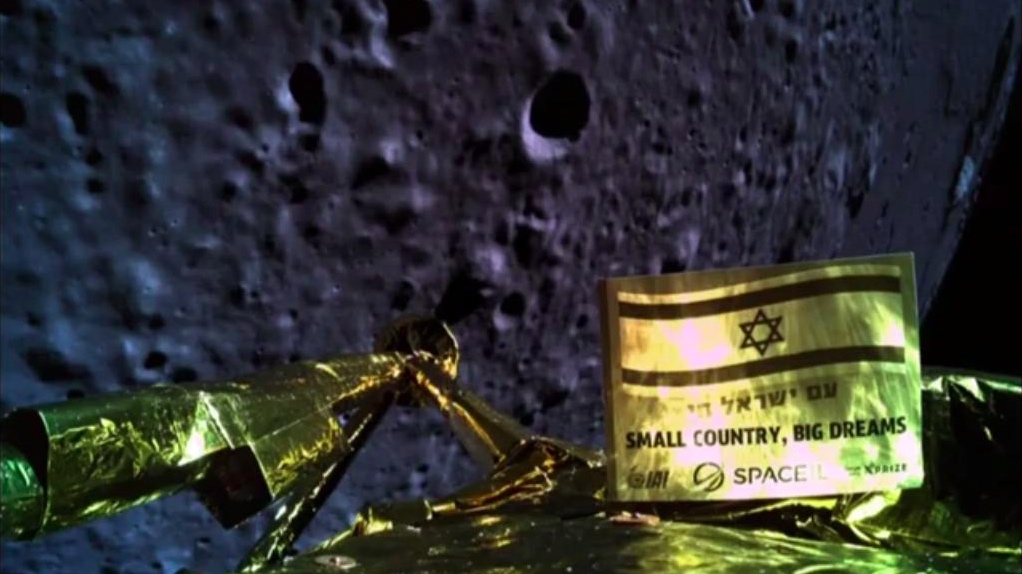
Manual Command Likely Caused Israeli Moon Lander's Crash
Final results of the crash investigation are expected in the coming weeks.

A preliminary investigation into what caused Israel's Beresheet spacecraft to crash-land on the moon April 11 puts the apparent blame on a "manual command" that was entered into the spacecraft's computer.
"This led to a chain reaction in the spacecraft, during which the main engine switched off, which prevented it from activating further," according to a statement released today (April 17) by Beresheet's handlers, the nonprofit group SpaceIL and the company Israel Aerospace Industries (IAI).
Teams continue to investigate further, in order to understand the full picture of what occurred during the mission, the statement says. "In the coming weeks, final results of the investigation will be released."
Related: Israel's 1st Moon Lander Beresheet in Pictures
LRO lookout
Meanwhile, researchers are on the lookout for a NASA piggyback experiment that may have survived Beresheet's destructive April 11 crash landing.
NASA's Lunar Reconnaissance Orbiter (LRO) will target the crash site repeatedly, eyeing the area with its high-powered cameras. In addition, LRO will use its onboard Lunar Orbiter Laser Altimeter (LOLA) in an attempt to detect a NASA-provided laser retro-reflector array in the Beresheet wreckage zone.
Called the NASA Goddard Space Flight Center/MIT Laser Retroreflector Array (LRA) for Lunar Landers, the ball-shaped device was located on the top side of Beresheet.
Get the Space.com Newsletter
Breaking space news, the latest updates on rocket launches, skywatching events and more!
The size of a computer mouse, LRA is composed of eight mirrors made of quartz cube corners that are set into a dome-shaped aluminum frame. That array is lightweight, radiation-hardened and long-lived.
From the high-flying LRO, laser beams generated by LOLA would strike the device and then bounce back to the orbiter. For each laser beam, LOLA measures its time of flight, or range.
Overhead passes
While there will be many attempts to target the wreckage, LRO is directly over the site only twice per month, and one of those passes occurs in darkness (which is not an issue for the laser), explained the Massachusetts Institute of Technology's David Smith, the principal investigator for LOLA and an emeritus researcher at NASA Goddard in Greenbelt, Maryland.
"But the site can be viewed on several passes around the 'overhead' pass by looking off to the side or forward or backward. This requires the spacecraft to slew or roll to see the target," Smith said.
"That's a decision that LRO makes to ensure there are no issues with regard to constraints on pointing close to the sun or star cameras being able to see the stars (and not the lunar surface)," he added., So, the process requires requests for slew and role magnitudes and directions to the LRO project for a specific observation time.
Pointing requests
This is normal procedure, Smith said, but typically researchers need to submit pointing requests about a week in advance. That allows the LRO project to check on pointing abilities (there are limits) of LRO and on thermal effects and spacecraft solar array pointing for charging the batteries.
"It may take 10 to 15 minutes for the spacecraft to turn to the desired direction and another 15 minutes to return to its normal nadir mode for just a few seconds of observations," Smith told Inside Outer Space.
"I am sure the project will start to attempt observations as soon as possible," Smith said. LRO's camera system and the laser are co-boresighted, "so when the camera slews to take an image, the laser altimeter automatically goes with it and will attempt to make a range observation at the same time."
At a speed of over 3,300 mph (5,310 km/h), the whole LRO observation period is over in a few seconds, Smith said.
- Israel's 1st Moon Lander: The SpaceIL Beresheet Lunar Mission in Pictures
- Latest Moon Photos by NASA's Lunar Reconnaissance Orbiter
- Israeli Moon Lander Snaps Epic Space Selfie with a Full Earth
Leonard David wrote the forthcoming book "Moon Rush: The New Space Race," to be published by National Geographic in May 2019. A longtime writer for Space.com, David has been reporting on the space industry for more than five decades. Follow us on Twitter @Spacedotcom or Facebook.
Join our Space Forums to keep talking space on the latest missions, night sky and more! And if you have a news tip, correction or comment, let us know at: community@space.com.

Leonard David is an award-winning space journalist who has been reporting on space activities for more than 50 years. Currently writing as Space.com's Space Insider Columnist among his other projects, Leonard has authored numerous books on space exploration, Mars missions and more, with his latest being "Moon Rush: The New Space Race" published in 2019 by National Geographic. He also wrote "Mars: Our Future on the Red Planet" released in 2016 by National Geographic. Leonard has served as a correspondent for SpaceNews, Scientific American and Aerospace America for the AIAA. He has received many awards, including the first Ordway Award for Sustained Excellence in Spaceflight History in 2015 at the AAS Wernher von Braun Memorial Symposium. You can find out Leonard's latest project at his website and on Twitter.









